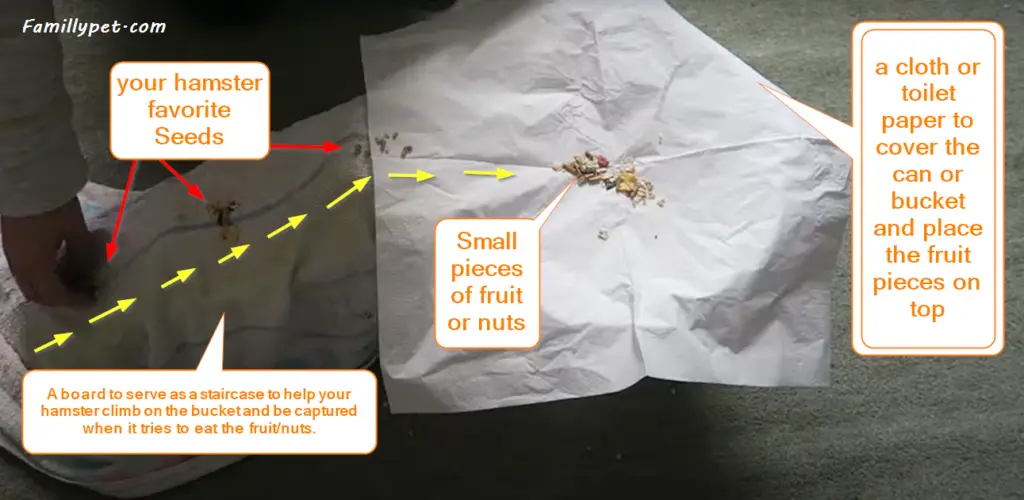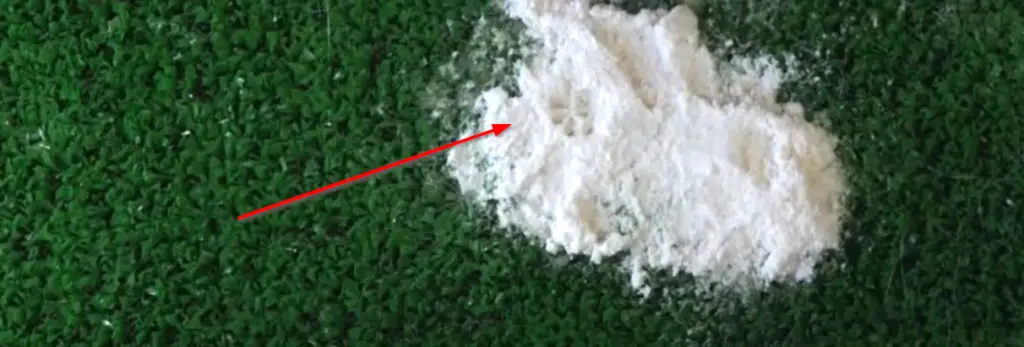No sign of missing hamster, what to do ?
As soon as you discover that your hamster is missing, close the cage’s room door , the front door of the house and any other exit that could take your missing hamster out of the house. Put your cat and dog in an empty room or have them watch, put food and water in several corners of the house, start searching for your hamster and set your bucket traps.
Why do hamsters escape from their cages?
Hamsters are exploratory animals, and their wild counterparts travel many miles each night, for many reasons:
- To find a new virgin territory and richer than his own
- To find food
- To find a female or a male
- To reach a watering hole
Hamsters feel cramped even in cages larger than 1000 square inches.
A hamster is always looking for a way to get out of its cage, so don’t make it easy for it to do so:
Use the proper cage, an aquarium or glass cage for dwarf hamsters and a cage with tight grills for others.
Know also that if a hamster manages to pass its head by a hole, the rest of its body will be able to pass also, it is for that that the hamsters even Syrians escape by holes that you will believe too small for them!
After the adventurous instinct, boredom is the second common reason that pushes hamsters to escape from their cage.
Therefore, you should choose a large (over 1000 inches square), secure cage for your hamster and offer it all the enrichment it can get:
- Toys
- Chew toys
- Hideouts
- Food scattering
- Sticks and twigs
- Cage runs
- Sandbox for his cleaning sessions
- A good thickness of bedding (+ 12 inches at least on one side of the cage) so that he can dig holes.
- A wheel adapted to his body and silent.
- Tunnels and ladders
- Hanging vegetable skewers
Each time you clean the cage, put some of the old litter back in to keep the smell, but have the items in the cage change places to encourage your hamster to explore the cage again and avoid boredom.
Why do hamsters escape at night and how do they orient themselves in the dark?
Hamsters escape at night because they are crepuscular and nocturnal animals and especially to avoid being seen and captured by predators.
Hamsters use echolocation in the dark to detect obstacles, they emit sounds inaudible to our ears.
They also use their whiskers, their sense of smell to find food in the dark, orient themselves and create a 3D map of your house to find their way even when the lights are off
Finally, they leave an olfactory trace everywhere they go thanks to two glands in each side of his belly, which allows him to find his burrow or his cage if he wants to return after his walk.
A female hamster in heat or a hamster that is hungry or thirsty can escape from the cage, and they can do it just by instinct because as I said, they are exploratory animals that run long distances at night, they need that for their well being and their health.
What to do when you discover that your hamster has escaped from its cage?
As soon as you notice that your hamster is missing, here are the steps to follow:
1- Check that the hamster is not hiding in its nest, its hideouts or in a new hole in its litter box. From now on, you must watch where you put your feet and always open the doors of the rooms carefully, it could be behind any of these doors or any other furniture in your house.
2– Once you are sure that the hamster has escaped, quickly run and close the bedroom door, take a quick look around the house and close the front, back and cat or dog doors.
Also check the bathroom and close its door and the garage door and any room that could be a danger to your hamster.
Secure the stairs if your hamster lives upstairs.
3-Pick up your cat, dog, ferret or any other pet and put it in a room where you are sure the hamster is not hiding or have your family watch it.
4- Remove your cat’s food and litter box and put it up high and do this with any other food, especially sweets that your hamster might find access to (secure the food in your house)
5- Quickly set up small bowls or plates, place a small bowl of water in each room and a definite and equal number of seeds in another bowl or just on the floor, choose the ones your hamster prefers the most (remember the number of seeds).
You can also add a small piece of fruit that has a strong smell, such as banana, strawberry, apple, but just a tiny piece.
6- Carefully place your hamster’s empty cage on the floor or make it easier to access by adding a ladder if it is high and put some food in it.
7-Prepare one or more containers, boxes or small cages to create traps (Bucket traps) to capture your hamster if it is still in the house.
8- Do an inspection of your backyard, garage, garden, pool …. Before nightfall and pray that your hamster has not already left the house!
9- Let your neighbors know that your hamster has escaped and could very well be in their backyard and be prepared to contact petshops, animal shelters, rescue pets … and make an announcement on facebook if you can’t find your hamster in the next two days.
10- The best time to look for your hamster in the house is at dusk and early morning, sometimes it is enough to listen to hear your hamster tickling or dropping things, which will help you locate him and put him back in his cage.
What are the risks of a hamster escaping from its cage?
Hamsters are safe in their cage, but once outside, they must be supervised.
Because of this, a hamster that escapes from its cage runs many dangers, here are some of them:
Falling from the roof of its cage just after its escape and breaking a bone or an internal organ, it would be death in a few days generally!
Being surprised by your cat, snake or dog and triggering their hunting instinct, which will cost your hamster its life.
Finding its way out of your home and being the victim of an owl, coyote or other predator or simply a car trying to cross the road.
Getting sick from eating cat or dog food, or finding sweets on the floor and eating them (chocolate for example).
Chewing on electrical wires, falling down the stairs, dropping something on your head while trying to climb a tablecloth or a stool…
Being stepped on by a family member who will wake up at night to drink some water!
How to find & catch a hamster that escapes from its cage ?
1- Find out in which room the fugitive is hiding:
First you have to secure the house and close all the exits and then start by detecting the room where the hamster is hiding
For this, you just have to listen to hear your hamster making noise or chewing things, this at dusk or at night
You can also put a known number of seeds in each room, close all the doors and the next day, check in which room there are missing seeds and your hamster is hiding in that room.
2- Catch the hamster and put it back in its cage:
After discovering the room where your hamster is hiding; you might go directly to retrieve your hamster behind a piece of furniture or under the sofa or a bed …
But if the room is full of hiding places and objects and you do not have access to the interstices and all the corners, you must set a trap for your hamster, we will use the Bucket trap:
This trap, as shown in the photo, consists of a bucket or an empty can; that you will cover with a cloth or a small fabric and put on top of nuts or pieces of fruit.
Also put a ramp to make it easier for your hamster to climb up to the pieces of fruit and fall into the bucket when it tries to eat them.
You can also lure your hamster with a tube for example, plug one end of the tube, put some seeds at the bottom of the tube and lay it on the ground
Hamsters love tunnels and holes, he will surely refuse and you will easily recover him the next day.
Find and Capture your Escaped hamster with some flour:
You can use a little flour to find out which room your missing hamster is hiding in.
Get your vacuum cleaner ready for an after cleaning.
Take a bag of flour and place a handful or two in each room where you suspect your hamster is hiding.
Your hamster will probably be attracted to the smell of the small pile of flour and will go looking for it and in doing so, will probably leave its footprints in the flour.
You will know the next day in which room the fugitive is hiding to look for him and capture him or set traps with treats if it is difficult to access.
4- Your Missing hamster will not come out to eat if it is scared or stressed
In this case, you have to listen, look in the nooks and crannies, even in the wall or the air vents.
Use pieces of apples placed all over the house to make sure your hamster will not starve and as soon as you discover its place, use even the biggest means to get it back, like taking down a wall or removing a big piece of furniture ….
You may need to use a light, dry towel to throw at your hamster if it comes out of hiding and tries to run away again.
Once you have retrieved and caught your hamster, check its health, make sure it is not dehydrated or injured ….
Put him back in his cage and find out how he escaped to secure the cage.
If you can’t find out how your hamster escaped from its cage, wait until nightfall, it will surely try again.
How to escape proof your hamster cage ?
Start by choosing the ideal cage for your hamster
A large aquarium or glass cage for Dwarfs and a small bar cage for Syrians (I never recommend a cage smaller than 1000 inches square)
Then secure the door of the cage with a small padlock because hamsters learn quickly to open the door
Also check that there are no holes in the cage walls large enough for your hamster’s head to pass through, because if his head does pass through, the hamster can escape.
When the cage does not have a roof, as with aquariums, make sure that the height of the walls is everywhere double the height of your hamster when it stands on its hind legs.
How long will a missing hamster that has escaped survive outside?
Months if it has access to food and water; its instinct to find or dig a burrow will quickly take over and the hamster will have a better chance of survival outside the winter.
Final thoughts
Remember that securing your hamster’s cage is better than having to look for it every time!
Give your hamster some enrichment so that it doesn’t get bored inside and try to escape
Give your hamster enough food and water, hunger can cause it to escape
If your hamster escapes and leaves the house, notify your neighbors to keep an eye out and make a wanted poster on Facebook and tape it up outside.
Also look for your missing hamster at your local animal shelter, someone might have found him a few blocks away…
If you don’t find it, know that it’s also part of having a hamster at home, they sometimes run away and live in the wild. So don’t be sad but don’t give up looking.







